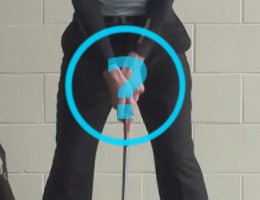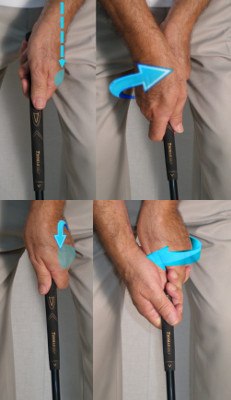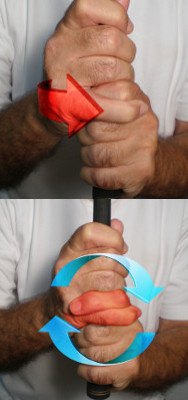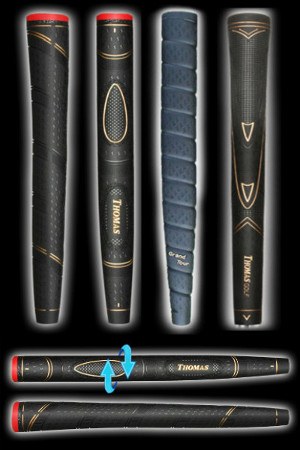
You've probably seen countless tips for placing your hands on the grip of a golf club, but they typically leave out one VERY important step. We're going to share it with you.
Gripping the club properly is crucial, and is well covered by articles explaining the various styles (neutral, strong, overlapping, interlocking, etc.). However, the key step missing from most golf instruction involves the direction of the clubface when taking your.
So, there are actually TWO parts to a proper golf grip: hand placement and clubface direction.
- Stand with your feet and shoulders parallel to the target line and hold the club in front of you, with the clubhead at about eye level. Rotate the club face to make sure it is aimed directly parallel to your target line. Put another way, the face should be at a 90° angle to the line. (The patented shot alignment indicator on Thomas Golf equipment is a big advantage here! Simply aim the indicator down your target line.)
- With the clubface still at eye level and aimed at the target, take your grip. The back of the left hand (for right-handers) should be aligned with the clubface, facing the target. (Note: This position is called a neutral grip. For those who prefer to use a “strong” grip, turn your left hand 1-5° to the right before grasping the club.)
- Using the grip style of your preference (overlapping, interlocking, baseball), place your right hand on the club. With your fully formed grip, bring the club down to normal address position and check the positioning.
Gripping with a square clubface helps ensure it is square at impact. You should repeatedly practice gripping the club using this method until it becomes second-nature. Failing to align the club correctly with your grip may create any number of issues, including:
- Gripping the club in a slightly different place each time, causing inconsistency.
- A clubface pointed in the wrong direction at address. To try to correct this, the golfer will often turn the club by rolling their hands into a less ideal position. This adjustment is lost once the golfer's arms begin the swing. Even a small error in club direction or hand position can make a big difference, so you don't want to compromise either.
- Compensating during the swing. A poor grip forces the golfer to adjust his swing, compounding the problem.
Some tips on gripping the club refer to the direction of the V's formed by the thumb and index finger on each hand. However, we consider this an unreliable method because these V's are hard to judge, and can vary greatly from golfer to golfer due to hand shape, thickness, etc.
The way you grip the golf club is going to have a lot to do with the results you achieve on the course.

While there are a variety of grip options available to you as a player, you need to be sure that the grip you choose matches up with the needs of your swing. If your grip is essentially fighting against your swing, it's always going to be hard to reach your potential.
In this article, we are going to provide a variety of tips related to the grip. At the heart of these tips will be the goal of improving the accuracy of your golf shots. It is easy to get caught up in the pursuit of more and more distance, but accuracy is really what will take you to a new level in golf. Think about it – when you lose a stroke during the course of a round, is it because you didn't have enough power, or is it because your shot was inaccurate? Most of the time, it is going to be the latter. By hitting the ball on target a high percentage of the time, your game is bound to improve. It might be fun to strive for longer and longer drives, but players who are serious about lower scores know that control is the name of the game.
Of course, using a good grip alone will not be enough to make you an accurate golfer. There are any number of variables involved in the golf swing, and you need to dial in as many of them as possible to raise the overall level of your game. While the focus of this article is the grip specifically, you should always keep the big picture in mind while you practice. Only when everything comes together properly – your grip and the rest of your swing mechanics – can you look forward to exciting results.
All of the content below is based on a right-handed golfer. If you happen to play left-handed, please take a moment to reverse the directions as necessary.
Some Grip Basics

Before we get into some of the more specific details regarding the grip, we first need to tackle some basic fundamentals. The points listed in this section should be considered the basics – you should start here before moving on to everything else. While some of the finer points of the grip can get a bit complicated, the points we offer in this section are simple and straightforward. As long as you are checking off each of these points every time you grip the club, you can be confident that you are at least close to a quality grip.
Without further delay, let's dive into the fundamentals of a reliable golf grip.
- Comfort. One of the keys to a good golf grip is comfort. The grip is the only point of connection between your hands and the club itself, so it's important that your hands feel comfortable in the way they are wrapped around the handle. Of course, comfort is likely to improve with experience and practice, but you shouldn't be trying to place your hands on the club in a manner that is totally uncomfortable and unnatural for you. What feels comfortable is going to vary from player to player, meaning you don't necessarily have to copy anyone else in order to have a good grip. In the end, you are going to need to strike a balance between paying attention to key fundamentals and making yourself comfortable and confident. It may take some time to get there, but eventually – through hard work and practice – you will find a grip that you can love and trust.
- Relaxed grip pressure. Another main ingredient in a successful grip is relaxed grip pressure. This is a point that really seems to give amateur golfers a lot of trouble. The average golfer tends to hold onto the club much too tightly, which results in a stiff and restricted swing. If the movements made by the rest of your body are going to transfer through your hands and into the club, your grip needs to be relatively relaxed. Now, with that said, you certainly can't let the club go flying out of your hands as you swing. So, again here, we are talking about finding a nice balance. You'll need enough grip pressure to keep the club securely in your hands all the way to the finish, but not so much that your swing is restricted along the way. A good way to find the right amount of grip pressure is to work your way up from short shots. Hit a few practice chip shots while using very little grip pressure. Experiment with how firmly you need to grip the club in order to keep it under control while you chip. Then, move up to pitch shots, and so on, until you are hitting drives down the range. By taking the gradual approach, you should get a good feeling for what it is like to use a relaxed grip, and how that grip feels with your various clubs.
- Consider a glove. Some people look at a golf glove as an option piece of equipment rather than a necessary item. And, to be sure, it is optional. You don't have to wear a golf glove to play this game, and plenty of golfers – including some professionals – have been successful without using a glove. However, for the majority of players, wearing a glove is a good idea. The glove can offer you a nice amount of traction on the grip as you swing, and that added traction may help you use a relaxed grip pressure with more success. Should you go barehanded, it might be necessary to squeeze the club just to keep it in your hands. This is especially true if you are playing in the rain, or if your hands tend to sweat. If you aren't sure whether or not a golf glove is the right choice for you, there is only one thing to do – give it a try. Golf gloves are not particularly expensive, so pick one up at your local golf shop and see how it feels.
- Practice, practice, practice. To make sure the club feels as comfortable as possible in your hands, one thing you can do is simply rehearse your grip as frequently as possible. Even if you aren't at the golf course, just pick up a club and form your grip from time to time. If you do this when you have a spare minute or two around the house, or at the office, you can gradually get more and more comfortable with your grip. Then, when you do go out to play golf, your grip will be second nature and your mind will be free to focus on other things.
The basics of a good golf grip are pretty simple. The club should feel comfortable in your hands, and you should use a relaxed grip pressure to allow the club to move freely through the ball. Also, you should think about wearing a glove and you should rehearse your grip as often as you can. These points might not take you all the way to a perfect grip, but they do make up a solid foundation. From here, we can get into some of the finer points related to building an excellent grip.
Finding the Perfect Left Hand Position

One of the things you may find surprising about the golf grip is that your non-dominant hand actually plays the more important role on the club. So, for a right-handed golfer, that obviously means the left hand. By placing your left hand properly on the club, you can set yourself up for success. The right hand has its own role to play as well, of course, and we will get to that in a minute.
The big question regarding your left hand is what position you are going to place it in when you grip the club. Will it be in a weak, neutral, or strong position? First, a quick explanation of those three terms. When your hand is turned significantly to the left on the grip (as seen from above), you are using a weak grip. As you continue to turn it farther and farther right, your grip gets stronger. You can use the number of knuckles you are able to see on the back of your left hand as a guide to understanding where you are on this spectrum. If you can see two or fewer knuckles, you are in weak grip territory. If you can see two and a half knuckles, you are right in the middle of what would be considered a neutral grip. Once you get up to being able to see three or even all four knuckles, you have a strong grip.
Unfortunately, we can't tell you which is going to be better for your swing. Some golfers find success with a weak grip, while others can only produce quality shots when they use a strong grip. The points below may help you get a little closer to determining which will be better for your game.
- Why use a weak grip? You are likely to benefit from a weak grip if you play a control-based game that is focused on accuracy and precision more than raw power. Often, players with weak grips don't make a particularly aggressive turn through the ball, instead using solid mechanics to strike clean shots time after time. While there are exceptions to every rule, it tends to be the case that those using a weak grip are in the category of shorter hitters. With that said, you shouldn't not eliminate the idea of a weak grip just because it does not lend itself to tremendous power. What you might give up in the way of power you could gain in control. A weak grip is capable of releasing the club head beautifully through the ball at impact. Once this kind of grip becomes natural and comfortable within your swing, you may be able to play the game with a level of precision you never thought possible.
- Why use a strong grip? As you might imagine, the key points for a strong grip are pretty much the opposite of what they are for a weak grip. In this case, you are a player who turns hard through the ball, adding impressive speed to the club before impact. With a strong grip and a powerful turn, you can hold the face of the club square through the hitting area. Although the strong grip is most commonly associated with a draw, you can actually use it effectively to produce a nicely controlled fade as well. For many amateurs, this is the type of grip that will feel more comfortable when getting started in the game, since it makes it easier for you to get your hands and wrists involved in the action. However, that's where you can run into trouble – if you aren't disciplined, the strong grip can lead to a swing which uses too much hand action.
It would be great if we could tell you exactly how to place your left hand on the club in order to get the best possible results. Of course, we can't do that. We can, however, encourage you to experiment with different hand positions on the driving range. Watch how your ball flight changes as you adjust your grip and eventually you should be able to settle on a left hand position that leads to positive outcomes.
Once you've finally settled on a place for your left hand, finding a home for your right hand is quick and easy. Simply put, you want to match up your palms when you form your grip at address. So, with your left hand already on the grip, just place your right hand on the grip in such a way that the palms are facing each other directly. Then, close your fingers around the back of the club and get ready to hit your shot.
Overlap or Interlock?

To be honest, it's surprising that we made it this far in the article without talking about the choice you'll need to make between two types of grips – overlapping and interlocking. In reality, there are more options than just these two, but these are the two methods used by the overwhelming majority of golfers. Most likely, you are going to find your best grip in one of these two options.
The overlapping grip is one where the pinky finger of the right hand is set on top of the back of the left hand when the grip is formed. Traditionally, that pinky finger rests in the crease between the pointer and middle finger of the left hand. This is different than the interlocking grip, which has the pinky finger of the right hand laced between the second and third finger of the left hand. Either of these two options can do the job of bringing the hands together successfully in the grip.
So, which one should you use? Well, first of all, you've probably already made this decision – at least for now. If you already play golf, you already have some kind of grip, even if you aren't particularly happy with it. In order to decide to change your grip from its current method to the opposite style, you will need to have a strong reason to do so. Changing from interlocking to overlapping, or vice versa, is not an easy adjustment to make. It will take time to go from one to the other, so only attempt it if you are confident that you will be rewarded for your effort.
There are a couple of things to think about when trying to decide whether you are going to use an interlocking grip or an overlapping grip. The first thing is hand size. Generally speaking, players with larger hands will be better served with the overlapping grip, while those with smaller hands tend to prefer the interlocking option. That is not a hard and fast rule, however, so don't make your decision on that point alone.
Another thing to think about is the way you use your hands during the swing. If you need the freedom to use your hands through the hitting area – to release the club fully – you may want to lean toward an overlapping grip. By not interlocking your fingers, the grip will make it easier for the club to release nicely through the ball. For those who prefer to keep the club stable through the ball while limiting the release, going with the interlocking option is worth consideration. There is a lot of stability to be enjoyed with this grip, and the right hand will still be able to do enough at the bottom of the swing to square the club face properly.
The only way to be sure you have the right style of grip is to experiment for yourself on the range. Just as we mentioned in the previous section with regard to left hand position, you will again need to experiment with each of these two kinds of grips. Assuming you already use one of these grips, spend some time testing out the other one to see if it works better. You will need to give it a few practice sessions to get any kind of meaningful result, since there is a period of adjustment to be expected. After some practice time has been invested, go with the option you feel most confident in moving forward.
A Word on Equipment

To finish up this article, we need to mention the importance of the actual grip you place on each of your golf clubs. In this sense, the word 'grip' is referring to the piece of golf gear slid onto the end of each shaft to give your hands somewhere to land. Grips are commonly overlooked in the golf equipment world, but they are actually quite important. Without the right grip on each club, you will be making the game harder than it needs to be.
When shopping for grips, there are a couple of things you need to know. First, you should pay attention to the thickness of the grip, as there are various options available on the market. If you have big hands, or just like a thicker grip, make sure to pick out the right model. Should you need help finding the right model, be sure to ask for help in your local pro shop. Another important thing to watch for is the makeup of the grip. Some grips have pieces of cord running up and down the grip, to provide extra traction. These types of grips are great for control, but they can be rough on your hands. There is no right or wrong here – just check out the options and decide which will be best for your needs.
Once you find a grip that you like, and you have those grips installed on your clubs, be sure to keep those grips in good condition. Wipe them down when you are done playing, and make sure to dry them off thoroughly after a wet round. Even with good care, golf grips don't last forever. In fact, if you play regularly, you may only get one season out of a set of grips. Have them replaced before they get too worn so you don't have to play without the traction you need to be successful.
The grip is something that isn't discussed all that often in the golf world, at least not compared to some of the other key fundamentals in the game. If you are willing to take some time to learn about your grip and how it impacts what you do with your swing, you will have a leg up on the competition. We hope the information offered in this article will help you get the best possible performance out of your grip. Good luck!






